Leadership's Influence on Corporate Governance: A Comprehensive Report
VerifiedAdded on 2020/07/22
|13
|3692
|45
Report
AI Summary
This report provides a comprehensive overview of the role of leadership in corporate governance. It begins by defining leadership and its significance within an organization, emphasizing its ability to guide and motivate individuals toward achieving set goals. The report then explores the relationship between leadership and corporate governance, highlighting how effective leadership brings transparency and clarity to organizational practices. It delves into the importance of corporate governance, its advantages, and its impact on economic growth. The report also examines various leadership theories, including the Great Man theory, Behavioral theory, and Contingency theory, and how these theories influence corporate governance and employee engagement. Finally, it discusses different leadership styles, such as autocratic, laissez-faire, transactional, transformational, and participative, and their respective links with corporate governance and employee engagement, providing insights into their advantages and disadvantages and their suitability for different organizational contexts. The report concludes by underscoring the importance of leadership in fostering ethical decision-making and ensuring sustainable business practices, ultimately contributing to the well-being of society and the economy.

Role of Leadership
Paraphrase This Document
Need a fresh take? Get an instant paraphrase of this document with our AI Paraphraser

TABLE OF CONTENTS
INTRODUCTION...........................................................................................................................1
TASK ..............................................................................................................................................1
CONCLUSION ............................................................................................................................8
REFERENCES..............................................................................................................................10
INTRODUCTION...........................................................................................................................1
TASK ..............................................................................................................................................1
CONCLUSION ............................................................................................................................8
REFERENCES..............................................................................................................................10

INTRODUCTION
Leadership refers to a skill that encompasses the ability of a person or firm to guide and
lead other individuals, team or whole organisation. It is an art to motivate group of people to
work towards the attainment of set goals. Leader is an individual who influences others with his
actions. He has the ability to motivate and encourage team members and provide them path to
follow in order to complete assigned tasks in specific period of time. Leadership is also defined
as the capability to convert vision into reality (Antonakis and Day, 2017). It plays an important
role in the organisation. Leaders develop teams and strategies, provide training to employees by
identifying their needs, communicate instructions to group members, listen their problems and
maintain a healthy relationship in between employer and employee. They highly contribute in the
growth and sustainability of firm by attaining objectives in an effective manner. The report
covers significance of leadership and its different theories. It also includes corporate governance
and its role in bringing transparency in the practices and activities of firm. Apart from this, role
of leadership in influencing practices and activities of effective corporate governance is also
defined in this report.
TASK
Leadership and Corporate Governance
Leadership is defined as an ability of firm's management to set and attain goals of
company, take decisions, face competition and encourage others to perform in a better way. It
administers the direction for a firm. An effective leadership includes:
Creating an inspiring vision
Inspiring and motivating individuals to engage with vision
Managing delivery of vision
Coaching and developing an effective team so that vision can be attained
Ideas are the basis of effective leadership but it is necessary to communicate them to
others in such a way that they engage enough to act as leader wants. In businesses, leadership
plays a crucial role. It assists in improving the performance of firm not only in terms of profit
but, in every aspect (Boin, Stern and Sundelius, 2016). Leaders increase the bottom line of
business by assistance of their effective leadership skills. Leadership is a winning mixture of
personal traits or characteristics as well as it is the ability to think and act like a leader. It is the
capability to be an individual who directs actions and activities of others.
1
Leadership refers to a skill that encompasses the ability of a person or firm to guide and
lead other individuals, team or whole organisation. It is an art to motivate group of people to
work towards the attainment of set goals. Leader is an individual who influences others with his
actions. He has the ability to motivate and encourage team members and provide them path to
follow in order to complete assigned tasks in specific period of time. Leadership is also defined
as the capability to convert vision into reality (Antonakis and Day, 2017). It plays an important
role in the organisation. Leaders develop teams and strategies, provide training to employees by
identifying their needs, communicate instructions to group members, listen their problems and
maintain a healthy relationship in between employer and employee. They highly contribute in the
growth and sustainability of firm by attaining objectives in an effective manner. The report
covers significance of leadership and its different theories. It also includes corporate governance
and its role in bringing transparency in the practices and activities of firm. Apart from this, role
of leadership in influencing practices and activities of effective corporate governance is also
defined in this report.
TASK
Leadership and Corporate Governance
Leadership is defined as an ability of firm's management to set and attain goals of
company, take decisions, face competition and encourage others to perform in a better way. It
administers the direction for a firm. An effective leadership includes:
Creating an inspiring vision
Inspiring and motivating individuals to engage with vision
Managing delivery of vision
Coaching and developing an effective team so that vision can be attained
Ideas are the basis of effective leadership but it is necessary to communicate them to
others in such a way that they engage enough to act as leader wants. In businesses, leadership
plays a crucial role. It assists in improving the performance of firm not only in terms of profit
but, in every aspect (Boin, Stern and Sundelius, 2016). Leaders increase the bottom line of
business by assistance of their effective leadership skills. Leadership is a winning mixture of
personal traits or characteristics as well as it is the ability to think and act like a leader. It is the
capability to be an individual who directs actions and activities of others.
1
⊘ This is a preview!⊘
Do you want full access?
Subscribe today to unlock all pages.

Trusted by 1+ million students worldwide

According to the viewpoints of Antonakis and Day, (2017), leadership is an act of leading
individuals in a company towards attaining goals. Leaders influence the behaviour of employees
in several ways. A clear vision for company is set by them. They motivate the workforce and
guide them through work process as well as boost up their morale.
Significance of leadership:
Leadership is a vital function of management which assists in increasing the efficiency
and attaining organisational goals. Below mentioned are some points that define the importance
of leadership:
Providing guidance: A leader supervises as well as guides his subordinates so that they
will perform their work in a better way (Clough and McClellan, 2016). He provides directions to
employees to make them work efficiently and effectively.
Coordination: By reconciling individual’s interest with goals of organisation, co-
ordination can be attained. Synchronization can be accomplished by effective and proper
coordination which must be the prime motive of a leader.
Builds work environment: Management is a process of getting things done by others.
Healthy work environment assists in gaining stable growth. So, it is necessary for a leader to
consider the human relations. They have the responsibility to listen problems of their workforce
and administer them with an appropriate solution.
Initiates actions: Leader is an individual who takes initiatives to work by conveying
plans and policies to subordinates.
Creating confidence: It is a factor which can be attained by expressing work efforts to
team members, clearly explaining their roles and providing direction to attain the goals
effectively.
Corporate Governance refers to a system of practices, processes and rules by which an
organisation is directed and controlled. It includes balancing the interest of management,
shareholders, suppliers, customers, government, community and financiers. It administers the
framework for achieving objectives of company. It refers to the way in which a corporation is
governed. It practically encompasses every sphere of administration from internal controls and
action plans to corporate disclosure and performance measurement (Li, 2016). Governance
principles and structures determine the distribution of responsibilities and rights among various
participants in company as well as include procedures and rules for making decisions regarding
2
individuals in a company towards attaining goals. Leaders influence the behaviour of employees
in several ways. A clear vision for company is set by them. They motivate the workforce and
guide them through work process as well as boost up their morale.
Significance of leadership:
Leadership is a vital function of management which assists in increasing the efficiency
and attaining organisational goals. Below mentioned are some points that define the importance
of leadership:
Providing guidance: A leader supervises as well as guides his subordinates so that they
will perform their work in a better way (Clough and McClellan, 2016). He provides directions to
employees to make them work efficiently and effectively.
Coordination: By reconciling individual’s interest with goals of organisation, co-
ordination can be attained. Synchronization can be accomplished by effective and proper
coordination which must be the prime motive of a leader.
Builds work environment: Management is a process of getting things done by others.
Healthy work environment assists in gaining stable growth. So, it is necessary for a leader to
consider the human relations. They have the responsibility to listen problems of their workforce
and administer them with an appropriate solution.
Initiates actions: Leader is an individual who takes initiatives to work by conveying
plans and policies to subordinates.
Creating confidence: It is a factor which can be attained by expressing work efforts to
team members, clearly explaining their roles and providing direction to attain the goals
effectively.
Corporate Governance refers to a system of practices, processes and rules by which an
organisation is directed and controlled. It includes balancing the interest of management,
shareholders, suppliers, customers, government, community and financiers. It administers the
framework for achieving objectives of company. It refers to the way in which a corporation is
governed. It practically encompasses every sphere of administration from internal controls and
action plans to corporate disclosure and performance measurement (Li, 2016). Governance
principles and structures determine the distribution of responsibilities and rights among various
participants in company as well as include procedures and rules for making decisions regarding
2
Paraphrase This Document
Need a fresh take? Get an instant paraphrase of this document with our AI Paraphraser

corporate affairs. As per the viewpoints of Moghaddam, (2016), corporate governance involves
the processes by which objectives of corporation are set and pursued in terms of regulatory,
social and market environment. Its mechanism consists of monitoring the practices, policies,
decisions and actions of organisations, their agents as well as stakeholders. The practices related
to corporate governance are impacted by attempts to align shareholder's interest.
Advantages of corporate governance:
Good and effective corporate governance ensures economic growth and success of
corporate (Moghaddam, 2016).
Strong corporate governance assists in maintaining confidence of investors, as a result of
which, organization can raise funds in an efficient and effective manner.
It lowers the cost of capital.
There is a positive effect on the price of share.
It renders proper inducement to employers as well as administrator to attain objectives
that are in favour of the organization and shareholders.
Good corporate governance minimizes corruption, wastage, mismanagement and risks.
It assists in brand development and formation.
It ensures that firms are managed in such a manner that fits the interests of all
participants.
According to the viewpoints of Re and Rule, (2016), corporate governance is defined as
an interaction among different participants in shaping performance and strategies of firm. In an
organisation, the relationship between employer and manager should be healthy and no conflicts
should take place among them. It is necessary for the owner to measure actual performance of
individuals with standard one. The dimensions of corporate governance must not be overlooked.
It ensures transparency and safeguards the interest of shareholders. It assured that stakeholders
can completely exercise their rights. It has a wider scope as includes both institutional as well as
social aspect. Corporate governance stimulates moral, trustworthy and ethical environment. It
gives complete responsibility and authority to the board of directors (Morone and Kersh, 2016).
In today's competitive or market oriented economy, need for governance arises. Globalization as
well as efficiency are the important components urging corporate governance. It is necessary to
develop in order to add value to stakeholders.
3
the processes by which objectives of corporation are set and pursued in terms of regulatory,
social and market environment. Its mechanism consists of monitoring the practices, policies,
decisions and actions of organisations, their agents as well as stakeholders. The practices related
to corporate governance are impacted by attempts to align shareholder's interest.
Advantages of corporate governance:
Good and effective corporate governance ensures economic growth and success of
corporate (Moghaddam, 2016).
Strong corporate governance assists in maintaining confidence of investors, as a result of
which, organization can raise funds in an efficient and effective manner.
It lowers the cost of capital.
There is a positive effect on the price of share.
It renders proper inducement to employers as well as administrator to attain objectives
that are in favour of the organization and shareholders.
Good corporate governance minimizes corruption, wastage, mismanagement and risks.
It assists in brand development and formation.
It ensures that firms are managed in such a manner that fits the interests of all
participants.
According to the viewpoints of Re and Rule, (2016), corporate governance is defined as
an interaction among different participants in shaping performance and strategies of firm. In an
organisation, the relationship between employer and manager should be healthy and no conflicts
should take place among them. It is necessary for the owner to measure actual performance of
individuals with standard one. The dimensions of corporate governance must not be overlooked.
It ensures transparency and safeguards the interest of shareholders. It assured that stakeholders
can completely exercise their rights. It has a wider scope as includes both institutional as well as
social aspect. Corporate governance stimulates moral, trustworthy and ethical environment. It
gives complete responsibility and authority to the board of directors (Morone and Kersh, 2016).
In today's competitive or market oriented economy, need for governance arises. Globalization as
well as efficiency are the important components urging corporate governance. It is necessary to
develop in order to add value to stakeholders.
3

As per the views of Ward (2016), both leadership as well as corporate governance are
important for organisations. With effective leadership, governance can successfully bring in the
practices of firm. Corporate governance brings transparency and clarity in the practices and
activities of firm as well as it links with the development of society. In short, it means good
protection of stakeholder's assets and natural resources of earth in order to ensure that present
operations of businesses are sustainable beyond the current generation. Leaders are responsible
for bringing transparency in practices and activities of organisation (Priest and Gass, 2017). They
are liable to take ethical decisions for company which cannot harm the resources of environment
and ensures growth as well as sustainability of business. Corporate governance is a concept that
is linked with the well-being of society. Many organisations are now doing their business with
corporate governance. They adopt ethics and values in business practices so that both the
motives can be fulfilled; profitability as well as social responsibility. All these can only be done
by effective leadership. A leader is an individual who is responsible for implementing all these
policies and practices in business so that objectives can successfully be attained. Corporate
governance ensures the growth and development of economy.
Leadership theories are applied by the leaders in every organization. It helps leaders to
manage the employees and firm. Their leadership skills assist in managing the behaviour of
workforce and provide direction to them. Below are the various leadership theories and their
effects on corporate governance are:
Great Man theory – As per the viewpoints of Ward, (2015), leaders are made and they
cannot be created. No particular features, characteristics and traits are identified in the person.
But from the birth, they have traits of the leader. This theory also says that leaders can adopt
leadership style according to relevant situation. These leaders can do audit in their organization
any time. Government needs not to interfere in their matters. They can manage their firm with
own rules and regulations. Thus, they can manage and regulate the firm more properly.
Behavioural theory – This theory emphasizes on the working and behaviour of leader. It
totally focuses on how a leader behaves and responds towards different situations, evaluate the
success and correlate particular behaviour with success. As per the viewpoints of Re and Rule,
(2016), leaders are not born but they can be made. If leader behaves in a fair manner then
employees have trust on them. So, if government does audit then subordinates do not have fear
that firm is not properly working and performing.
4
important for organisations. With effective leadership, governance can successfully bring in the
practices of firm. Corporate governance brings transparency and clarity in the practices and
activities of firm as well as it links with the development of society. In short, it means good
protection of stakeholder's assets and natural resources of earth in order to ensure that present
operations of businesses are sustainable beyond the current generation. Leaders are responsible
for bringing transparency in practices and activities of organisation (Priest and Gass, 2017). They
are liable to take ethical decisions for company which cannot harm the resources of environment
and ensures growth as well as sustainability of business. Corporate governance is a concept that
is linked with the well-being of society. Many organisations are now doing their business with
corporate governance. They adopt ethics and values in business practices so that both the
motives can be fulfilled; profitability as well as social responsibility. All these can only be done
by effective leadership. A leader is an individual who is responsible for implementing all these
policies and practices in business so that objectives can successfully be attained. Corporate
governance ensures the growth and development of economy.
Leadership theories are applied by the leaders in every organization. It helps leaders to
manage the employees and firm. Their leadership skills assist in managing the behaviour of
workforce and provide direction to them. Below are the various leadership theories and their
effects on corporate governance are:
Great Man theory – As per the viewpoints of Ward, (2015), leaders are made and they
cannot be created. No particular features, characteristics and traits are identified in the person.
But from the birth, they have traits of the leader. This theory also says that leaders can adopt
leadership style according to relevant situation. These leaders can do audit in their organization
any time. Government needs not to interfere in their matters. They can manage their firm with
own rules and regulations. Thus, they can manage and regulate the firm more properly.
Behavioural theory – This theory emphasizes on the working and behaviour of leader. It
totally focuses on how a leader behaves and responds towards different situations, evaluate the
success and correlate particular behaviour with success. As per the viewpoints of Re and Rule,
(2016), leaders are not born but they can be made. If leader behaves in a fair manner then
employees have trust on them. So, if government does audit then subordinates do not have fear
that firm is not properly working and performing.
4
⊘ This is a preview!⊘
Do you want full access?
Subscribe today to unlock all pages.

Trusted by 1+ million students worldwide

Contingency theory – As per the views of Sanders, (2017), leader should not follow a
particular path or leadership style. They have to change their methods and ways according to a
particular situation. Leaders follow their own plans and policies when they think that employees
can give response to them in the future. Staff members feel that the management can change its
strategies, fulfil the needs and requirements accordingly. This theory also responding to
variations in government rules and regulations.
Leadership styles and their link with corporate governance and employee engagement behaviour
Different styles of leadership are adopted by the leaders. Each style has some advantages
as well as disadvantages. Goals and culture of company determine style which is the best suitable
for firm. Some of the leadership styles are defined as below:
Autocratic: This type of leadership allows administrators to take decisions individually
without taking any input from others. Administrators possess full authority and impose their will
on subordinates. No one can challenge the decisions that are taken by autocratic leaders. Some
firms operates under this leadership style. It is beneficial for those employees who need close
supervision. Those individuals who are creative and flourish in group functions, dislike this style
of leadership.
Laissez Faire: These types of leaders lack direct oversight of workforce and fail to
administer continuous feedback of those individuals who are under their supervision. Trained
and experienced workforce need less supervision and falls under this style of leadership. All
employees do not possess these characteristics. As per the viewpoints of Sanders (2017), Laissez
Faire leadership style hampers the production of workers who need supervision. In this style,
managers do not put any efforts on the supervision or leadership which can lead towards lack of
control, increasing cost and poor production (Shapiro and Stefkovich, 2016).
Transactional: Managers with this leadership style receive certain tasks or activities to
perform and render punishments or rewards to team members on the basis of results of their
performance. Administrator and members of group set predetermined targets and goals
collectively and workers agree to precede the leadership and direction of manager to achieve
those goals and targets. Administrator possesses power to assess results and correct or train
employees when they fail to meet objectives and goals. Workers receive rewards like bonuses,
incentives, etc. when they get success in accomplishing the set goals.
5
particular path or leadership style. They have to change their methods and ways according to a
particular situation. Leaders follow their own plans and policies when they think that employees
can give response to them in the future. Staff members feel that the management can change its
strategies, fulfil the needs and requirements accordingly. This theory also responding to
variations in government rules and regulations.
Leadership styles and their link with corporate governance and employee engagement behaviour
Different styles of leadership are adopted by the leaders. Each style has some advantages
as well as disadvantages. Goals and culture of company determine style which is the best suitable
for firm. Some of the leadership styles are defined as below:
Autocratic: This type of leadership allows administrators to take decisions individually
without taking any input from others. Administrators possess full authority and impose their will
on subordinates. No one can challenge the decisions that are taken by autocratic leaders. Some
firms operates under this leadership style. It is beneficial for those employees who need close
supervision. Those individuals who are creative and flourish in group functions, dislike this style
of leadership.
Laissez Faire: These types of leaders lack direct oversight of workforce and fail to
administer continuous feedback of those individuals who are under their supervision. Trained
and experienced workforce need less supervision and falls under this style of leadership. All
employees do not possess these characteristics. As per the viewpoints of Sanders (2017), Laissez
Faire leadership style hampers the production of workers who need supervision. In this style,
managers do not put any efforts on the supervision or leadership which can lead towards lack of
control, increasing cost and poor production (Shapiro and Stefkovich, 2016).
Transactional: Managers with this leadership style receive certain tasks or activities to
perform and render punishments or rewards to team members on the basis of results of their
performance. Administrator and members of group set predetermined targets and goals
collectively and workers agree to precede the leadership and direction of manager to achieve
those goals and targets. Administrator possesses power to assess results and correct or train
employees when they fail to meet objectives and goals. Workers receive rewards like bonuses,
incentives, etc. when they get success in accomplishing the set goals.
5
Paraphrase This Document
Need a fresh take? Get an instant paraphrase of this document with our AI Paraphraser

Transformational: In this style of leadership, high level of communication is required by
managers in order to meet the set goals (Tömmel and Verdun, 2017). Transformational leaders
motivate workforce and improve their efficiency as well as productivity through high visibility
and communication. Engagement of management is required in this leadership style so that goals
can be effectually met. They emphasize on the big picture within firm and allocate smaller tasks
to team in order to accomplish goals.
Participative: This style is often called as democratic leadership. Leaders with this style
value inputs of employees and peers, but final decisions are taken by them only. They boost up
the morale of their workforce by providing them opportunity to take participation in the process
of decision making. It creates a sense of belongingness among employees. According to Vincent,
(2016), when changes are required within organisation, this style of leadership helps workforce
to accept those changes easily as they play an important part in the decision making process.
This leadership style meets challenges at the time when firms need to take decisions in short time
period.
Situational Leadership Model:
This model states that leadership is an act of administering right amount of arousal and
supervision that creates good learning environment. Situational leadership model has four steps
and on the basis of situation, a leader can jump on any step.
Directing: At this step, leaders administer a lot of direction and less support.
Coaching: Leaders provide increased support and less direction.
Supporting: In this, direction and support is less so that individual can become self-supporting.
Delegating: On the basis of need, leaders provide both direction as well as support.
This model helps the leader in performing their roles and responsibilities in an effective
way and influence corporate governance.
Difference between leadership styles:
6
managers in order to meet the set goals (Tömmel and Verdun, 2017). Transformational leaders
motivate workforce and improve their efficiency as well as productivity through high visibility
and communication. Engagement of management is required in this leadership style so that goals
can be effectually met. They emphasize on the big picture within firm and allocate smaller tasks
to team in order to accomplish goals.
Participative: This style is often called as democratic leadership. Leaders with this style
value inputs of employees and peers, but final decisions are taken by them only. They boost up
the morale of their workforce by providing them opportunity to take participation in the process
of decision making. It creates a sense of belongingness among employees. According to Vincent,
(2016), when changes are required within organisation, this style of leadership helps workforce
to accept those changes easily as they play an important part in the decision making process.
This leadership style meets challenges at the time when firms need to take decisions in short time
period.
Situational Leadership Model:
This model states that leadership is an act of administering right amount of arousal and
supervision that creates good learning environment. Situational leadership model has four steps
and on the basis of situation, a leader can jump on any step.
Directing: At this step, leaders administer a lot of direction and less support.
Coaching: Leaders provide increased support and less direction.
Supporting: In this, direction and support is less so that individual can become self-supporting.
Delegating: On the basis of need, leaders provide both direction as well as support.
This model helps the leader in performing their roles and responsibilities in an effective
way and influence corporate governance.
Difference between leadership styles:
6

CHARACTERISTICS DEMORATIC LAISSEZ-FAIRE AUTOCRATIC
Definition Democratic means
situation where there
is some authority to
subordinates also.
In this, there is more
authority to employees
as compared to
democratic style.
There is no
authority to
employees and
subordinates.
Decision making Democratic style
involves both top and
low level personnel
for the purpose of
judgement.
Here, views of lower
level workers are
involved but final
decision is in the hands
of managers.
In this style, there is
no involvement of
subordinates.
Motivation Views of employees
are also asked and so,
they are motivated.
In this category,
employees are highly
motivated.
There is no power
to employees and
hence, they are not
motivated.
Centralised and
decentralised
Organisation that opts
this strategy has
decentralisation of
power.
Decentralisation of
power, as it is dispersed
away from the central
authority.
Centralisation is in
organisation
Task delegation No delegation of task Up-to an extent,
delegation is there
Task is not
delegated
Productivity There is less
production as
employees are lenient.
This style gives
moderate production
returns as compared to
other two.
Highest production
is expected if
organisation applies
it.
Communication There is
communication from
both the sides i.e.
employee and
employer.
There is gap between
communication
between superiors and
subordinates.
There is more flow
of instructions from
top level
management.
7
Definition Democratic means
situation where there
is some authority to
subordinates also.
In this, there is more
authority to employees
as compared to
democratic style.
There is no
authority to
employees and
subordinates.
Decision making Democratic style
involves both top and
low level personnel
for the purpose of
judgement.
Here, views of lower
level workers are
involved but final
decision is in the hands
of managers.
In this style, there is
no involvement of
subordinates.
Motivation Views of employees
are also asked and so,
they are motivated.
In this category,
employees are highly
motivated.
There is no power
to employees and
hence, they are not
motivated.
Centralised and
decentralised
Organisation that opts
this strategy has
decentralisation of
power.
Decentralisation of
power, as it is dispersed
away from the central
authority.
Centralisation is in
organisation
Task delegation No delegation of task Up-to an extent,
delegation is there
Task is not
delegated
Productivity There is less
production as
employees are lenient.
This style gives
moderate production
returns as compared to
other two.
Highest production
is expected if
organisation applies
it.
Communication There is
communication from
both the sides i.e.
employee and
employer.
There is gap between
communication
between superiors and
subordinates.
There is more flow
of instructions from
top level
management.
7
⊘ This is a preview!⊘
Do you want full access?
Subscribe today to unlock all pages.

Trusted by 1+ million students worldwide

Where to use When there is equal
weightage to superior
and subordinates
In organisations, where
employees are free to
take their decision and
can be change as per
requirements of
business.
In this, there is more
responsibility on
leaders and they
carry all data.
Corporate governance can only be introduced by leaders in the practices and policies of
business. Leaders with their effective leadership skills successfully implement corporate
governance. Leadership plays an important role in the growth and sustainability of firm. Role of
corporate governance is to protect the interest of stakeholders of company such as customers,
suppliers, shareholders, investors, financiers, etc. and it is the responsibility of leader to take care
of it (Tummers and Knies, 2016). Leaders have responsibility to bring transparency in the
practices of business. Leadership and corporate governance highly contribute in the growth and
development of economy. Application of leadership theories and styles facilitate in increasing
participation of employees in the activities of firm.
CEOs play a crucial role in leading and shaping strategic direction of corporate
governance. They have the power to manage and lead business. They plan, implement and
monitor on strategic direction of team and business strategies. CEO provides direction to
company and bring transparency in the processes and practices with their effective leadership.
Effective ethical leadership and good governance are the two vital requirements of company to
be considered prospering in the eyes of stakeholders. Without effective leadership of CEO and
governance, it is virtually impossible to attain and sustain effective management to accomplish
goals, maintain quality and deliver high quality services. CEO exercises their power in the
management of economic and social resources of country for development. The important
principles of governance includes effectiveness and efficiency in providing services to society
and proper use of human as well as physical resources. If leaders don't have competency, they
may not be able to perform his responsibility effectively which results in misuse of resources.
Corporate governance includes the development of effective management policies and practices
involving transparency, strategic planning, accountability and effective systems of HRM.
8
weightage to superior
and subordinates
In organisations, where
employees are free to
take their decision and
can be change as per
requirements of
business.
In this, there is more
responsibility on
leaders and they
carry all data.
Corporate governance can only be introduced by leaders in the practices and policies of
business. Leaders with their effective leadership skills successfully implement corporate
governance. Leadership plays an important role in the growth and sustainability of firm. Role of
corporate governance is to protect the interest of stakeholders of company such as customers,
suppliers, shareholders, investors, financiers, etc. and it is the responsibility of leader to take care
of it (Tummers and Knies, 2016). Leaders have responsibility to bring transparency in the
practices of business. Leadership and corporate governance highly contribute in the growth and
development of economy. Application of leadership theories and styles facilitate in increasing
participation of employees in the activities of firm.
CEOs play a crucial role in leading and shaping strategic direction of corporate
governance. They have the power to manage and lead business. They plan, implement and
monitor on strategic direction of team and business strategies. CEO provides direction to
company and bring transparency in the processes and practices with their effective leadership.
Effective ethical leadership and good governance are the two vital requirements of company to
be considered prospering in the eyes of stakeholders. Without effective leadership of CEO and
governance, it is virtually impossible to attain and sustain effective management to accomplish
goals, maintain quality and deliver high quality services. CEO exercises their power in the
management of economic and social resources of country for development. The important
principles of governance includes effectiveness and efficiency in providing services to society
and proper use of human as well as physical resources. If leaders don't have competency, they
may not be able to perform his responsibility effectively which results in misuse of resources.
Corporate governance includes the development of effective management policies and practices
involving transparency, strategic planning, accountability and effective systems of HRM.
8
Paraphrase This Document
Need a fresh take? Get an instant paraphrase of this document with our AI Paraphraser

CONCLUSION
From the above information, it can be summarised that leaders highly contribute in the
success and growth of enterprise. Leaders play a vital role in the concept of corporate
governance and provide number of benefits to enterprise. Leadership helps firm in identifying
the needs and interest of various stakeholders. This assists the organisation to retain its customers
for a long period of time. Leadership styles and theories help the leaders in handling problems
effectively that are faced by organisation. This assists in maintaining coordination among
employees so that they will stay motivated and contribute in attaining the objectives of firm.
Corporate governance helps the managers in bringing transparency and clarity in practices and
processes of organisation.
9
From the above information, it can be summarised that leaders highly contribute in the
success and growth of enterprise. Leaders play a vital role in the concept of corporate
governance and provide number of benefits to enterprise. Leadership helps firm in identifying
the needs and interest of various stakeholders. This assists the organisation to retain its customers
for a long period of time. Leadership styles and theories help the leaders in handling problems
effectively that are faced by organisation. This assists in maintaining coordination among
employees so that they will stay motivated and contribute in attaining the objectives of firm.
Corporate governance helps the managers in bringing transparency and clarity in practices and
processes of organisation.
9

REFERENCES
Books and Journals
Antonakis, J. and Day, D. V. Eds., 2017. The nature of leadership. Sage publications.
Boin, A., Stern, E. and Sundelius, B., 2016. The politics of crisis management: Public leadership
under pressure. Cambridge University Press.
Clough, J. D. and McClellan, M., 2016. Implementing MACRA: implications for physicians and
for physician leadership. Jama. 315(22). pp.2397-2398.
Li, C., 2016. Chinese Politics in the Xi Jinping Era: Reassessing Collective Leadership.
Brookings Institution Press.
Moghaddam, F. M., 2016. Rule of law. American Psychological Association.
Morone, J. A. and Kersh, R., 2016. By the people: Debating American government. Oxford
University Press.
Priest, S. and Gass, M., 2017. Effective Leadership in Adventure Programming, 3E. Human
Kinetics.
Re, D. E. and Rule, N. O., 2016. Predicting firm success from the facial appearance of Chief
Executive Officers of non-profit organizations. Perception. 45(10). pp.1137-1150.
Sanders, J. O., 2017. Spiritual leadership: Principles of excellence for every believer. Moody
Publishers.
Shapiro, J. P. and Stefkovich, J. A., 2016. Ethical leadership and decision making in education:
Applying theoretical perspectives to complex dilemmas. Routledge.
Tömmel, I. and Verdun, A., 2017. Political leadership in the European Union: an introduction.
Journal of European Integration. 39(2). pp.103-112.
Tummers, L. and Knies, E., 2016. Measuring public leadership: Developing scales for four key
public leadership roles. Public Administration. 94(2). pp.433-451.
Vincent, D., 2016. GENDER DIVERSITY IN THE NFL: THE IMPORTANCE OF FEMALE
LEADERSHIP IN A HISTORICALLY MALE-DOMINATED ORGANIZATION.
WILLAMETTE SPORTS LJ. 13. p.60.
Ward, J., 2016. Keeping the family business healthy: How to plan for continuing growth,
profitability, and family leadership. Springer.
10
Books and Journals
Antonakis, J. and Day, D. V. Eds., 2017. The nature of leadership. Sage publications.
Boin, A., Stern, E. and Sundelius, B., 2016. The politics of crisis management: Public leadership
under pressure. Cambridge University Press.
Clough, J. D. and McClellan, M., 2016. Implementing MACRA: implications for physicians and
for physician leadership. Jama. 315(22). pp.2397-2398.
Li, C., 2016. Chinese Politics in the Xi Jinping Era: Reassessing Collective Leadership.
Brookings Institution Press.
Moghaddam, F. M., 2016. Rule of law. American Psychological Association.
Morone, J. A. and Kersh, R., 2016. By the people: Debating American government. Oxford
University Press.
Priest, S. and Gass, M., 2017. Effective Leadership in Adventure Programming, 3E. Human
Kinetics.
Re, D. E. and Rule, N. O., 2016. Predicting firm success from the facial appearance of Chief
Executive Officers of non-profit organizations. Perception. 45(10). pp.1137-1150.
Sanders, J. O., 2017. Spiritual leadership: Principles of excellence for every believer. Moody
Publishers.
Shapiro, J. P. and Stefkovich, J. A., 2016. Ethical leadership and decision making in education:
Applying theoretical perspectives to complex dilemmas. Routledge.
Tömmel, I. and Verdun, A., 2017. Political leadership in the European Union: an introduction.
Journal of European Integration. 39(2). pp.103-112.
Tummers, L. and Knies, E., 2016. Measuring public leadership: Developing scales for four key
public leadership roles. Public Administration. 94(2). pp.433-451.
Vincent, D., 2016. GENDER DIVERSITY IN THE NFL: THE IMPORTANCE OF FEMALE
LEADERSHIP IN A HISTORICALLY MALE-DOMINATED ORGANIZATION.
WILLAMETTE SPORTS LJ. 13. p.60.
Ward, J., 2016. Keeping the family business healthy: How to plan for continuing growth,
profitability, and family leadership. Springer.
10
⊘ This is a preview!⊘
Do you want full access?
Subscribe today to unlock all pages.

Trusted by 1+ million students worldwide
1 out of 13
Related Documents
Your All-in-One AI-Powered Toolkit for Academic Success.
+13062052269
info@desklib.com
Available 24*7 on WhatsApp / Email
![[object Object]](/_next/static/media/star-bottom.7253800d.svg)
Unlock your academic potential
Copyright © 2020–2026 A2Z Services. All Rights Reserved. Developed and managed by ZUCOL.




